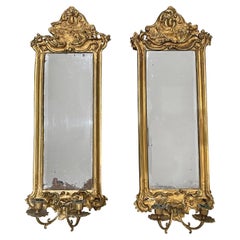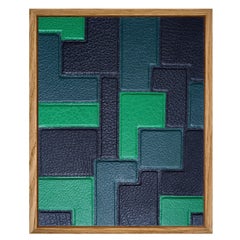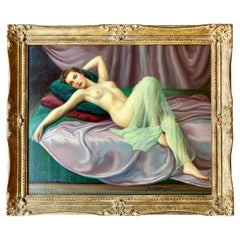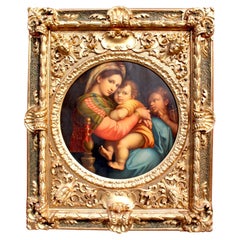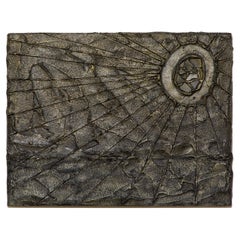Decorative Art
18th Century Swedish Gustavian Antique Decorative Art
Glass, Giltwood, Mirror
2010s Canadian Arts and Crafts Decorative Art
Leather, Wood
Mid-20th Century French Art Deco Decorative Art
Canvas, Paint
Early 1900s Italian Baroque Antique Decorative Art
Canvas, Giltwood
1970s American Brutalist Vintage Decorative Art
Resin, Wood
Early 20th Century French Other Decorative Art
Canvas
21st Century and Contemporary Spanish Organic Modern Decorative Art
Natural Fiber, Birch
Early 20th Century German Art Nouveau Decorative Art
Bronze
20th Century Polish Decorative Art
Paper
1980s American Vintage Decorative Art
Paper
19th Century Antique Decorative Art
Porcelain
Mid-20th Century French Mid-Century Modern Decorative Art
Wood
Late 19th Century Italian Victorian Antique Decorative Art
Canvas, Giltwood
20th Century Japanese Mid-Century Modern Decorative Art
Silk, Wood, Paper
Late 19th Century Unknown Folk Art Antique Decorative Art
Wood, Paper
2010s Panamanian Post-Modern Decorative Art
Metal
2010s Finnish Post-Modern Decorative Art
Ceramic, Wood
2010s Finnish Post-Modern Decorative Art
Ceramic, Wood
1980s French Art Deco Vintage Decorative Art
Gold Leaf
Early 20th Century Spanish Decorative Art
Canvas
Late 18th Century French Empire Antique Decorative Art
Giltwood
1970s American Vintage Decorative Art
Paper
Early 20th Century Belgian Decorative Art
Canvas, Wood
1970s Vintage Decorative Art
Ceramic
19th Century Chinese Chinese Export Antique Decorative Art
Wood
2010s Welsh Decorative Art
Wood
20th Century American Post-Modern Decorative Art
Canvas, Acrylic
Mid-19th Century English Folk Art Antique Decorative Art
Wool
Mid-19th Century Chinese Qing Antique Decorative Art
Metal
20th Century British Decorative Art
Metal
1970s Vintage Decorative Art
Ceramic
1990s English Decorative Art
Paper
1970s Israeli Mid-Century Modern Vintage Decorative Art
Aluminum
Early 20th Century German Black Forest Decorative Art
Walnut
20th Century American Decorative Art
Marble, Metal
19th Century Japanese Antique Decorative Art
Mid-19th Century English Victorian Antique Decorative Art
Canvas, Giltwood
Early 1900s Italian Baroque Antique Decorative Art
Canvas, Giltwood
1950s American Art Deco Vintage Decorative Art
Ceramic
1970s American Arts and Crafts Vintage Decorative Art
Wood, Paper
20th Century Unknown Decorative Art
Teak
Late 20th Century French Art Deco Decorative Art
Gold Leaf
1840s Antique Decorative Art
Giltwood
Mid-19th Century Chinese Qing Antique Decorative Art
Metal
1750s Antique Decorative Art
Canvas
2010s Panamanian Post-Modern Decorative Art
Fabric, Wood
1970s Mexican Brutalist Vintage Decorative Art
Brass
Mid-20th Century American Mid-Century Modern Decorative Art
Paper
20th Century Modern Decorative Art
Ceramic
1950s American Art Deco Vintage Decorative Art
Ceramic
1970s European Mid-Century Modern Vintage Decorative Art
Plastic, Wood
20th Century French Decorative Art
Canvas, Paint
20th Century Spanish Renaissance Revival Decorative Art
Gold Leaf
2010s Spanish Decorative Art
Wool, Cotton, Acrylic
19th Century French Antique Decorative Art
Wood
Late 19th Century Austrian Late Victorian Antique Decorative Art
Ceramic, Majolica
2010s Canadian Decorative Art
Aluminum, Steel
19th Century French Victorian Antique Decorative Art
Ormolu
Antique, New and Vintage Decorative Art
Antique, new and vintage decorative art is crucial to personalizing your interior.
Bringing art into your home will help you create a warm and welcoming atmosphere, whether you are expecting to regularly host guests for cocktails in your living room or you are inclined to soak up some “me time” on weekends by curling up with a book in your library. After all, a room isn’t quite complete until you hang some art on the walls.
Choosing a piece of art for your interior is a matter of finding something that resonates with you. You should also consider what will work with your current decor. Keep in mind that a wide range of objects counts as decorative art — antique and vintage prints, paintings, wall-mounted sculptures and more. There is so much to choose from! And art can feel as deeply personal with the vintage posters that promoted your favorite classic films as it can with framed photographs of your loved ones.
Decorative art can set the mood for a room and will typically make for great conversation. When you find wall decor and decorations that speak to you, why not introduce them into your space? It will give you and your guests the opportunity to meaningfully engage with the art every time you see it. You can play with different styles, eras and colors. Mix and match pieces to integrate a refreshing pop of color or create a theme by dedicating a room to a color palette or certain time period. A great way to tie your layout together is to choose wall art that complements your decor and color scheme.
Folk art is an interesting category for its wide range of works across various media and the array of textures it can offer. Paper art is another versatile option because it will be easy to find a home for portraits, collages, drawings and other works in your space. With decorative paper art, you can also get creative with how you arrange your wall art. There are plenty of options that include hanging the works salon-style.
On 1stDibs, find a constantly growing collection of antique and vintage decorative art today.
Read More
At Colonial Williamsburg, Everything Old Is New Again
With the help of a new director, the Virginia institution's folk art and decorative arts museums are undergoing extensive upgrades.
New York’s Hirschl & Adler Showcases the American Workmanship and Design Panache of Neoclassical Treasures
The gallery's latest exhibition proves that museum-quality pieces entice and inspire, whether in traditional or more modern interiors.
